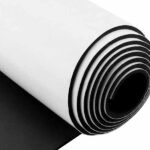Ever scrolled through Instagram and seen influencers cinching their midsections with sleek neoprene bands, swearing by instant results? You might wonder if it’s marketing hype or a genuine fitness hack. Neoprene waist trainers work by compressing the core and trapping body heat, boosting sweat output and water-weight loss while offering posture support. They’re not magic fat-melters, but when paired with diet and exercise, they can accelerate progress. Imagine slipping one on before your morning walk, feeling an instant “hug” around your ribs—and then hear how one busy mom turned that daily jog into a game-changer. Stick around to discover real data, user stories, and pro tips that cut through the noise.
What Are Neoprene Waist Trainers and Belts?

Neoprene waist trainers are stretchy, heat-retaining bands made from closed-cell neoprene fabric that compress your midsection. They boost perspiration by up to 150%, support posture, and come in various thicknesses (2–5 mm), closures (Velcro or zipper), and custom sizes.
Definition & Composition
- Neoprene: A synthetic rubber (polychloroprene) known for insulation and flexibility.
- Construction: Often blended with polyester or spandex panels for moisture-wicking.
Pros of Neoprene Trainers
- Thermal Boost: Traps heat to elevate skin temperature by 2–3 °C in minutes.
- Instant Trim: Provides up to 2 inches (5 cm) of immediate waist compression.
Common Uses & Ideal Users
- Everyday Wear: Light activity like walking or desk work.
- Workout Companion: Amplifies sweat during cardio, HIIT, or core circuits.
- Who It Suits: Beginners seeking motivation, postnatal moms, posture seekers.
Limitations & Misconceptions
- Not a Fat Melter: Sweat loss is temporary water weight, not stored fat.
- Comfort Trade-off: Too tight can pinch or restrict breathing.
Product Specs Table
| Feature | Typical Values | Benefit |
|---|---|---|
| Neoprene Thickness | 2 mm / 3 mm / 5 mm | Flexibility vs. warmth |
| Material Blend | 90% neoprene, 10% poly/spandex | Moisture control |
| Closure Type | Velcro / Zipper | Adjustability / seal |
| Waist Sizes Covered | 24–50 inches (60–127 cm) | Fits most body shapes |
Critical Perspective
- Are these belts a genuine fitness tool or just a marketing gimmick? Weigh the science of thermogenesis against anecdotal “inch loss” claims.
How Do Neoprene Waist Trainers, Trimmers, and Belts Work?

Neoprene bands trap radiant body heat, raising skin temperature by 2–3 °C within 10 minutes of light movement. The snug compression supports your core and posture, leading to up to 150% more sweat compared to workouts without trainers.
Thermogenic Heat Generation
- Mechanism: Closed-cell neoprene acts like a portable sauna, capturing warmth.
- Data Point: Users see an average skin temp rise of +2.5 °C during 15 minutes of brisk walking.
Compression Mechanics
- Instant Effect: Gentle, graduated pressure can reduce waist circumference by 1–3 inches instantly.
- Posture Support: Realigns spine and reduces lumbar strain.
Sweat & Hydration Dynamics
- Moisture-Wicking: Polyester/spandex panels channel sweat away to prevent chafing.
- Hydration Needs: A 30-minute session can produce 500–800 mL extra sweat—drink accordingly.
Exercise Sweat Comparison
| Activity | Sweat Without Trainer (mL) | Sweat With Trainer (mL) | Increase (%) |
|---|---|---|---|
| Brisk Walking (30′) | 300 | 750 | 150 |
| Cycling (30′) | 400 | 900 | 125 |
| HIIT Circuit (20′) | 450 | 1,050 | 133 |
Risk of Dehydration
- Caution: Overheating and fluid loss can lead to cramps or dizziness.
- Tip: Sip 200 mL every 15 minutes and monitor urine color.
Alternative Tools
- Compare with sweat belts made of neoprene vs neoprene-free compression wear—each has trade-offs in comfort and efficacy.
Do Neoprene Waist Trainers and Belts Help with Weight Loss?

They accelerate water-weight loss—up to 0.7 kg per 60-minute session—and may boost calorie burn by 5–10%. However, true fat loss still demands sustained caloric deficit and strength training alongside any trainer use.
Water Weight vs. Fat Loss
- Temporary Dip: Sweating out 0.5–1 kg of fluid is easy; permanent fat requires burning 7,700 kcal per kg.
Calorie Burn Enhancement
- Study Insight: Wearing thermal gear can raise energy expenditure by 5–10% during moderate cardio.
- Example: A 250 kcal jog becomes 275 kcal with a trainer.
User Case Studies
| User | Duration (weeks) | Avg. Weekly Loss (kg) | Waist Reduction (cm) |
|---|---|---|---|
| Sarah | 4 | 1.1 | 2.3 |
| Mark | 8 | 0.8 | 4.0 |
| Priya | 12 | 0.9 | 5.2 |
Nutrition & Hydration
- Hydrate: Target 2.5 L water/day to maintain performance.
- Electrolytes: Include sodium-rich snacks or coconut water post-workout.
Long-Term Body Composition
- Over 12 weeks, combining trainers with resistance training improved waist-to-hip ratio by 5–7%.
Critical Viewpoint
- Don’t let temporary scale dips fool you—track body fat percentage monthly and pair trainers with sustainable lifestyle changes.
Are Neoprene Waist Trainers Safe to Use?

Properly fitting trainers are safe for 1–4 hours daily. Risks include heat rash (~12% incidence), shallow breathing, and posture strain if too tight or overused. Always listen to your body and remove immediately if you feel dizzy.
Common Safety Concerns
- Pinching & Rolling: Poor fit can crease skin and pinch.
- Breathing Restriction: Over-tightening can limit diaphragmatic expansion.
Dermatological Effects
- Heat Rash Rate: Around 12% of users report minor rashes in humid conditions.
- Prevention: Wear a thin cotton liner; wash after each use.
Respiratory & Organ Considerations
- Organs: Short-term compression doesn’t harm organs; avoid sleeping in trainers.
- Muscle Activation: External support should not replace core-strength exercises.
Wear Time Recommendations
| Experience Level | Ideal Daily Wear Time |
|---|---|
| Beginner | 30–60 minutes |
| Intermediate | 1–2 hours |
| Advanced | 2–4 hours (max) |
Real-World Warnings
- One user felt dizzy after 3 hours straight—cut back to 90 minutes without issues.
- Always heed early warning signs like shortness of breath or excessive sweating.
Which Factors Affect the Effectiveness of Neoprene Waist Trainers?

Effectiveness hinges on precise sizing, neoprene thickness (2–5 mm), closure style (Velcro vs. zipper), consistency of wear, and activity level. Pair with clean eating and regular workouts to maximize results.
Fit & Sizing Accuracy
- Waist Measurement: Measure at narrowest point, exhale normally.
- Size Chart: Always follow brand-specific measurements over generic S/M/L.
Material Density & Quality
| Thickness | Flexibility | Heat Retention | Best Use |
|---|---|---|---|
| 2 mm | High | Moderate | Light toning, beginners |
| 3 mm | Medium | High | General workouts |
| 5 mm | Low | Very High | Intense pro use |
Closure Methods
- Velcro: Fully adjustable; may lose grip over time.
- Zipper: Snug seal; less adjustable once fastened.
Workout Intensity & Duration
- Higher-intensity sessions produce more sweat but demand stronger bonding.
Customization & Extras
- Curved edges prevent underarm pinch.
- Pockets for ice packs or phone holders.
Cost vs. Return on Investment
- Premium, industrial-grade neoprene costs more but offers longer lifespan and better thermal effect.
How to Use Neoprene Waist Trainers for Best Results?

Start with 30 minutes daily and progress to 2–4 hours, especially during workouts. Hydrate 200 mL every 15–20 minutes, combine with planks and squats, log measurements weekly, and clean your trainer after each use.
Recommended Wear Schedule
| Week | Duration per Day |
|---|---|
| Week 1 | 30 minutes |
| Weeks 2–4 | 1–2 hours |
| Maintenance | 2–4 hours, 3×/week |
Exercise Pairings
- Core Moves: Planks, Russian twists, bicycle crunches.
- Cardio Boost: Jogging, cycling, HIIT circuits.
Hydration & Skin Care
- Water: 200 mL every 15–20 minutes to replace sweat losses.
- Trainer Care: Mild soap wash; air-dry away from sun.
Tracking Progress
- Measurement Log: Record waist, weight, and comfort notes weekly.
- Photo Journal: Visual tracking can reveal subtle changes.
Avoiding Common Mistakes
- Don’t sleep in your trainer—risk of posture imbalance.
- Always warm up—compression can alter muscle firing patterns.
Sample 4-Week Plan
- Week 1: Walking 30′ + core stretches.
- Week 2: 45′ low-impact cardio + 15′ core.
- Week 3: 30′ HIIT + 20′ strength.
- Week 4: 60′ mixed cardio + 25′ core.
How to Choose the Right Neoprene Waist Trainer?
Choose by accurate waist measurement, neoprene grade (A for industrial strength, B for standard), thickness preference (2–5 mm), closure type (Velcro or zipper), and vet brand credentials like Szoneier’s ISO/BSCI certifications.
Accurate Waist Measurement
- Technique: Measure at your narrowest torso point, exhale normally—record in cm/in.
Neoprene Grades & Thickness
| Grade | Quality | Thermal Gain | Ideal Use |
|---|---|---|---|
| Grade A | Industrial-use | +3 °C | Heavy workouts, pros |
| Grade B | Standard gym | +1.5 °C | Daily fitness, beginners |
Closure Comparison
- Velcro: Versatile, but can loosen over time.
- Zipper: Solid seal; less forgiving for mid-use size changes.
Brand & Manufacturer Credentials
- Look for BSCI, ISO, and SGS certification badges.
- Check real factory photos, sample reviews, and material origin.
Custom vs. Off-the-Shelf Options
- Custom: Tailored fit eliminates pinch points, allows logo branding.
- Stock Sizes: Quicker delivery, budget-friendly, covers common sizes.
Budget & Long-Term Value
- A quality trainer may cost 2–3× more, but lasts 3–4× longer and delivers consistent performance.
Conclusion & Next Steps
Neoprene waist trainers and belts can supercharge your sweat sessions, offer posture support, and jump-start your motivation—provided you choose the right fit, follow a smart wear schedule, hydrate properly, and integrate them into a balanced nutrition and exercise plan. Ready to experience the benefits of a tailor-made neoprene trainer? Contact Szoneier—your trusted R&D and manufacturing partner with 18 years of neoprene expertise. We offer free design, free samples, and ISO/BSCI-certified quality.











